新概念英语二Lesson 2 Breakfast or lunch?课件(共26张PPT)
文档属性
| 名称 | 新概念英语二Lesson 2 Breakfast or lunch?课件(共26张PPT) | 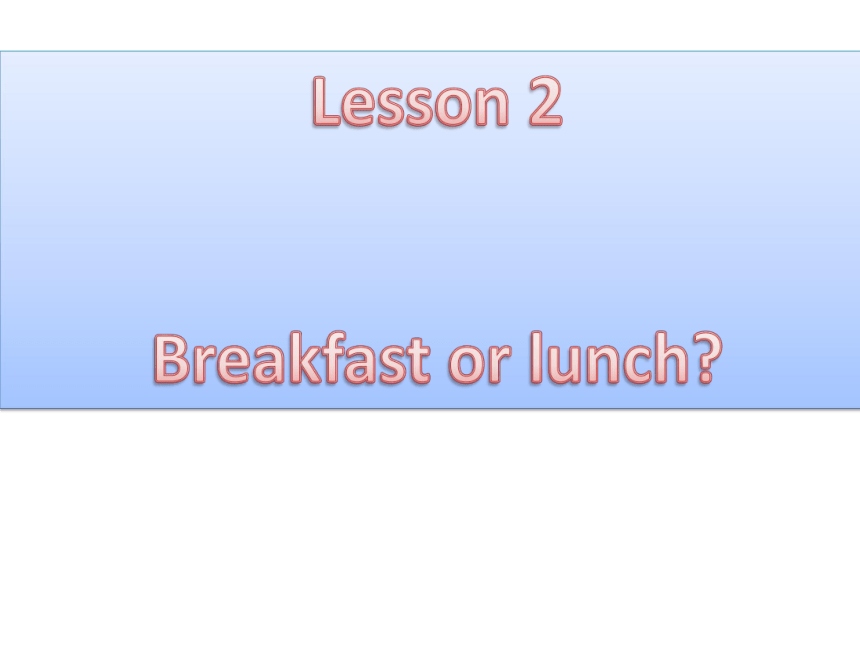 | |
| 格式 | pptx | ||
| 文件大小 | 1.7MB | ||
| 资源类型 | 教案 | ||
| 版本资源 | 新概念英语 | ||
| 科目 | 英语 | ||
| 更新时间 | 2024-01-01 09:13:27 | ||
图片预览

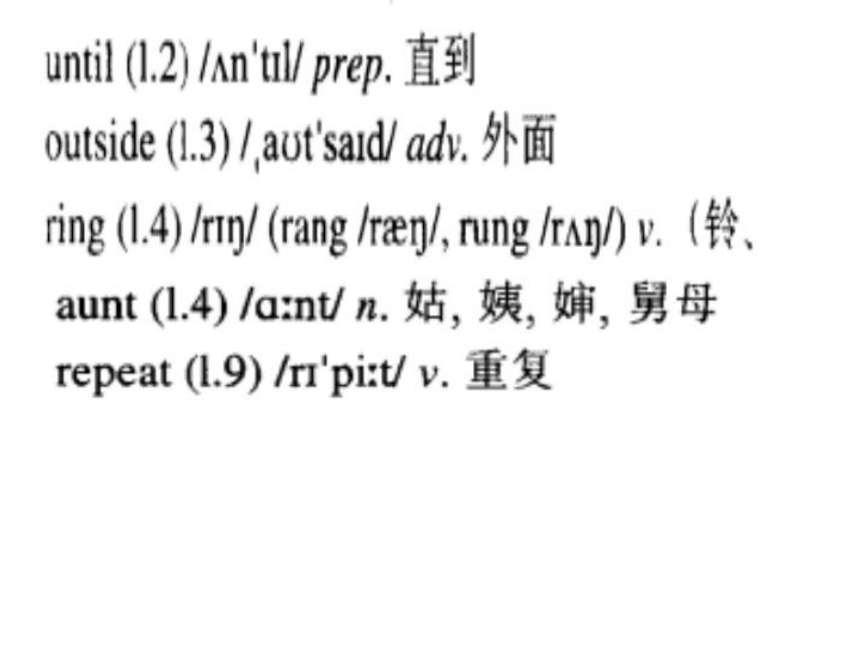
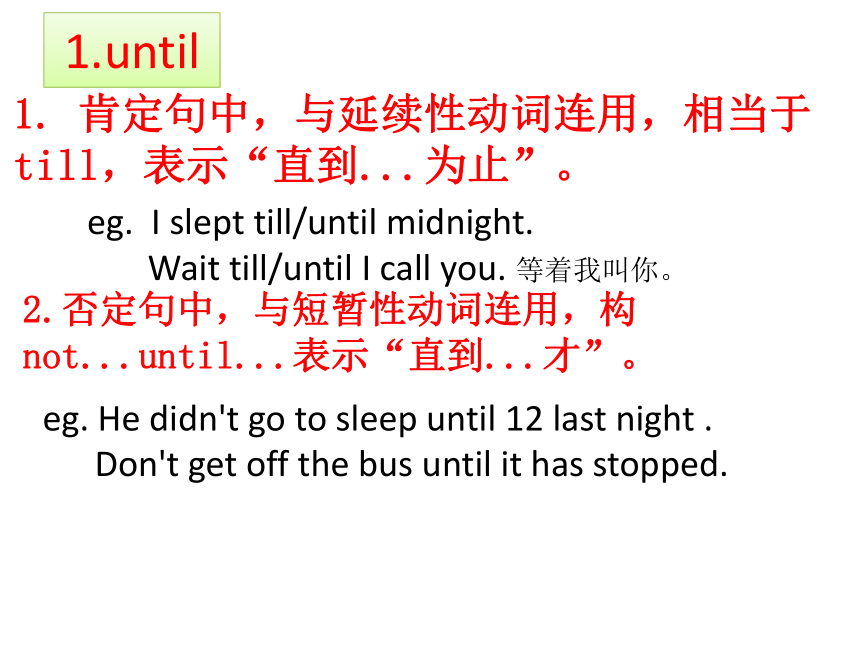
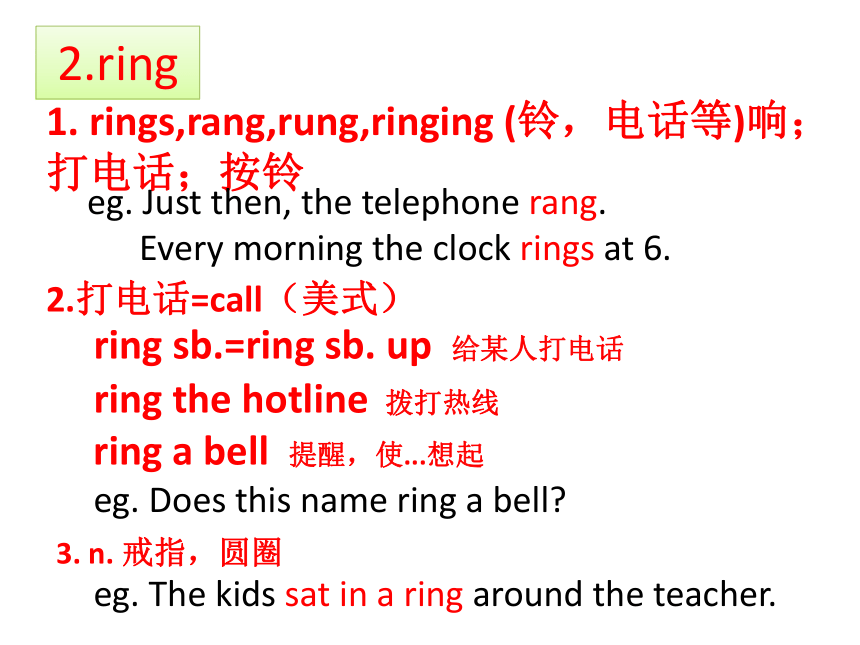
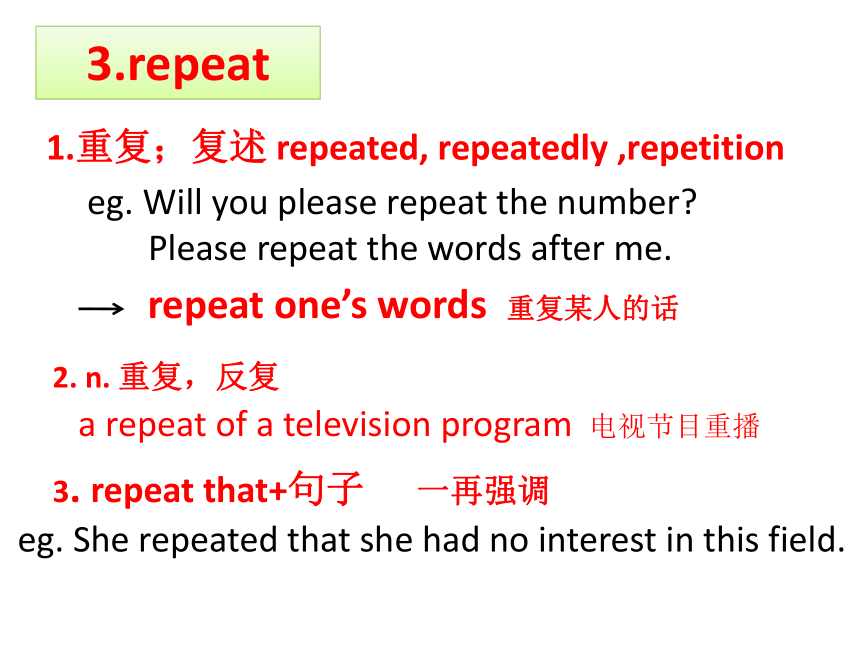
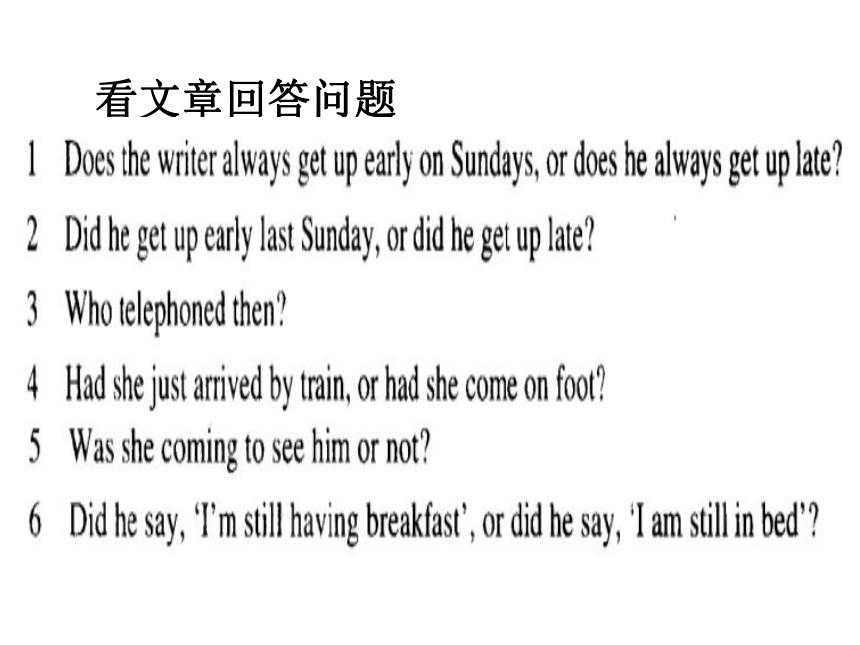
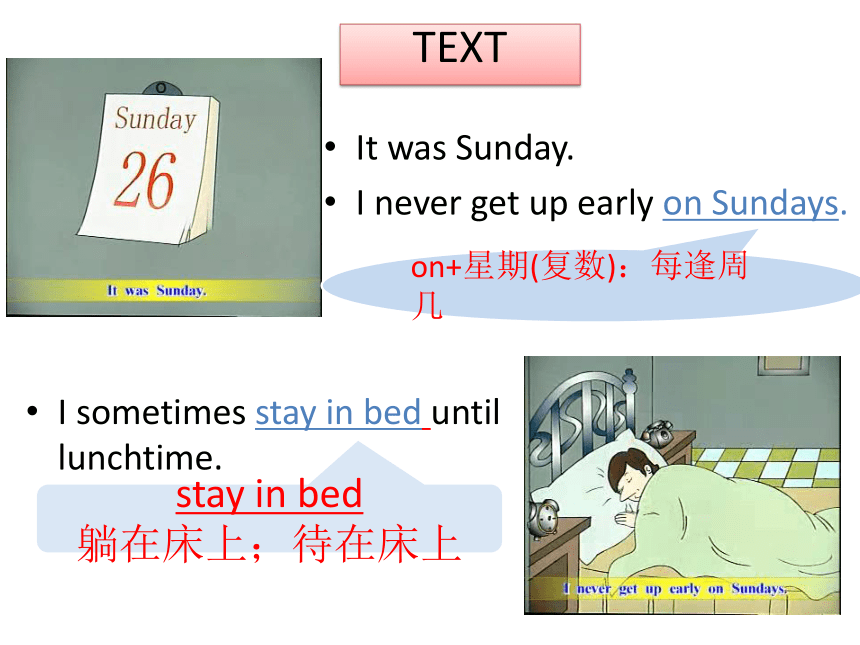
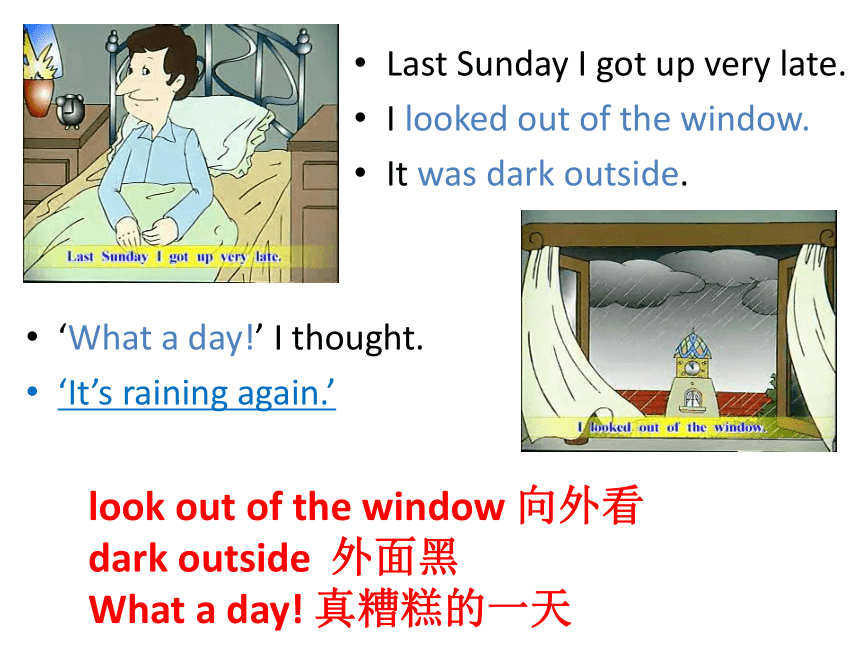
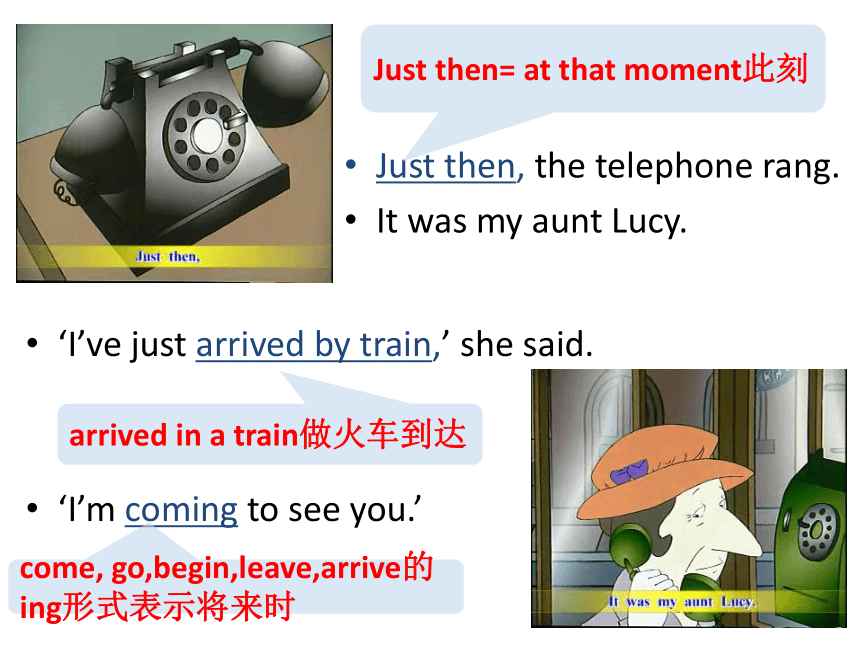
文档简介
(共26张PPT)
Lesson 2
Breakfast or lunch
1. 肯定句中,与延续性动词连用,相当于till,表示“直到...为止”。
1.until
2.否定句中,与短暂性动词连用,构not...until...表示“直到...才”。
eg. I slept till/until midnight.
Wait till/until I call you. 等着我叫你。
eg. He didn't go to sleep until 12 last night .
Don't get off the bus until it has stopped.
1. rings,rang,rung,ringing (铃,电话等)响;打电话;按铃
2.ring
2.打电话=call(美式)
eg. Just then, the telephone rang.
Every morning the clock rings at 6.
ring sb.=ring sb. up 给某人打电话
3. n. 戒指,圆圈
eg. The kids sat in a ring around the teacher.
ring the hotline 拨打热线
ring a bell 提醒,使...想起
eg. Does this name ring a bell
1.重复;复述 repeated, repeatedly ,repetition
3.repeat
3. repeat that+句子 一再强调
eg. Will you please repeat the number
Please repeat the words after me.
repeat one’s words 重复某人的话
2. n. 重复,反复
eg. She repeated that she had no interest in this field.
a repeat of a television program 电视节目重播
看文章回答问题
TEXT
It was Sunday.
I never get up early on Sundays.
I sometimes stay in bed until lunchtime.
stay in bed
躺在床上;待在床上
on+星期(复数):每逢周几
‘What a day!’ I thought.
‘It’s raining again.’
Last Sunday I got up very late.
I looked out of the window.
It was dark outside.
look out of the window 向外看
dark outside 外面黑
What a day! 真糟糕的一天
‘I’ve just arrived by train,’ she said.
‘I’m coming to see you.’
Just then, the telephone rang.
It was my aunt Lucy.
arrived in a train做火车到达
come, go,begin,leave,arrive的ing形式表示将来时
Just then= at that moment此刻
‘What are you doing ’ she asked.
‘But I’m still having breakfast,’ I said. 吃早饭
‘I’m having breakfast,’ I repeated.
‘Dear me!’ she said. 天呀
‘Do you always get up so late
It’s one o’clock!’
so + adj + a/an + n 如此怎样
1.概念:一般用来表示说话者的喜悦,惊讶等情感!
感叹句
eg. How clever the boy is!
What a day (it is)! 鬼天气!
eg. What a clever boy he is!
① How+adj./adv.+主+谓!
② What+(a/an)+adj.+n.+主+谓!
What+adj.+可n.复/不可n.+主+谓!
eg. What cute puppies (these are)!
What lovely weather (it is)!
How terrifying the experience is!
2.结构:
一般现在时:
概念:
1.表示现在的某种状况,常用be动词的结构。
3. 表示对所叙述动作的态度和看法,常用情动结构。
2. 表示经常. 反复发生的动作或行为,常用实动结构。
结构:
1. be动词的结构
肯定:
主语
+
am/is/are
adj.
n.
prep.
(表地点)
口诀:
我用am, 你用are, is跟着他她它,
单数is复数are, 走遍天下都不怕.
(1) 主语是非单三(I,we,you,they…)
主语+V原 +其他.
肯定:
don’t
Do
Wh-/How
一般现在时(2):实义动词的结构
主语+ + V原 +其他.
否定:
一般疑问:
主语+V原 +其他?
+
特殊疑问:
do+主语+V原 +其他?
+
Yes,主语+do.
No,主语+don’t.
(2) 主语是单三(he,she,it…)
主语+Vs/es +其他.
结构:
Vs/es的变化规则:
1.一般情况直接
2.以s,x,sh,ch结尾的
4.以辅音字母+y结尾的,
3.以o结尾的一般
5.不规则变化:
+s
+es
+es
+es
y
i
have
has
一般现在时(2):实义动词的结构
练习:写出下列单词的动词第三人称单数形式
go do
play jump
swim run
put sing
dance come
get have
主语+Vs/es +其他.
结构:
肯→否:
①请助动词doesn’t来帮忙,
放在主之后动之前。
② 动词现原形。即Vs/es→V原
肯→一般疑问句:
①请助动词Does来帮忙,放句首。
② 动词现原形。即Vs/es→V原
③ 第一人称变成第二人称;
I/we/me/us →you;
my/our→your; mine/ours→yours
myself→yourself; ourselves→yourselves
句型转换
频率副词:
1.always
一直
often
经常
sometimes
偶尔
seldom 很少
2. 位置:be动词之后,实义动词之前,
但表示强调时可放在句首或句尾.
usually
通常
一般现在时标志词:
3. 对频率副词进行提问时,用
how often
sometimes, some times, some time, sometime
sometimes 有时
some times有几次
sometime 某时
some time一段时间
always
一般过去时和always连用,表示经常或反复发生的动作。
过去进行时和always连用,表示赞扬,感叹,厌恶等。
一般现在时:(3)情态动词的结构
常用的情态动词:
can, may, must, need(否,疑),will,shall
结构:
主语+can/may/must…+V原 +其他.
肯→否:
在情态动词之后+not
(must )
needn’t
肯→疑问:
①情态动词提前放句首。
② 第一人称变成第二人称;
现在进行时:
1.概念:表示现阶段或说话时正在发生的动作或行为。
2.结构:
肯定句: 主语+ am/is/are + Ving + 其他.
否定句: 主语+ am /is/are +not + Ving + 其他.
一般疑问句:Am/Is/Are+主语 +Ving + 其他
Yes, 主语+am/is/are.
No, 主语+am not./isn’t./aren’t.
特殊疑问句:找词变句
(1.在am/is/are后加not. 2.some → any)
(1.Be 提前;2.第一人称→第二人称;3.some →any)
对Ving… 提问
What …… doing?
3.现在分词(Ving)的变化规则:
一般直接+ing.
以不发音字母e结尾;
去e
+ing.
take make see
taking
making
seeing
以辅元辅结尾,该音节重读,
双写尾字母
+ing.
单音节词:run, sit,swim, shut, put
多音节词:begin, forget, prefer(更喜欢)
(4).以ie结尾的词,
ie
y
+ing.
die(死) lie(躺着)
dying
lying
写出下列单词的ing形式:
go do
play jump
swim run
put sing
dance come
get have
4.现在进行时的标志词:
⑴ now 类:
现在
now
此时此刻
at the moment
这些天
these days
(2) 提示类:
Look!(看)
Listen!(听)
Be quiet!(安静点)
Hurry up!(快点)
( ) 1. --What are you doing ---We _________.
A. dance B. dances C. dancing D. are dancing
( ) 2. --What’ s your brother doing
-- .
A. He’s eating some cake. B. He’s watching TV.
C. She’s doing her homework. D. She’s sleeping.
( ) 3. Erin was always in class.
A. talk B. talks C. talking D. talked
( ) 4. Hurry up! Everybody for you at the gate.
A. waits B. are waiting C. is waiting D. wait
现学现练
Our teacher told us the sun ___ in the east and ____ in the west.
A. rose; set B. rises; sets C. rises; set D. rise; sets
John is from England. He _____ English.
A. spoke B. will speak C. speaks D. Had spoken
It’s nine o’clock. The students ______ a maths class.
A. have B. had C. is having D. are having
4. Look! They _____ a good time, _____ they
A. have; do B. have; don’t
C. are having; are D. are having; aren’t
5. Look! It _____ outside.
A. rains B. rained C. rain D. Is raining
The alarm _____ this morning.
A. ring B. rings C. rang D. rung
-- Would you like to have lunch with us
-- No, thank you. I ____ my lunch.
A. have B.have have C. had D. have had
9. Oh! Stop complaining! The bus ____.
A. comes B. came C. is coming D. Come
10. When I heard the bad news, I should “______!”
A. Excuse me B. Thank goodness
C. Okay D. Dear me
11. Standing in front of the painting, I said to myself, “______!”
A. What beautiful picture B. What a beautiful picture
C. What picture D. What a beautiful picture is it
12. Long ago, people didn’t know the earth _____ round the sun.
A. moves B. were moved C. moved D. had moved
Lesson 2
Breakfast or lunch
1. 肯定句中,与延续性动词连用,相当于till,表示“直到...为止”。
1.until
2.否定句中,与短暂性动词连用,构not...until...表示“直到...才”。
eg. I slept till/until midnight.
Wait till/until I call you. 等着我叫你。
eg. He didn't go to sleep until 12 last night .
Don't get off the bus until it has stopped.
1. rings,rang,rung,ringing (铃,电话等)响;打电话;按铃
2.ring
2.打电话=call(美式)
eg. Just then, the telephone rang.
Every morning the clock rings at 6.
ring sb.=ring sb. up 给某人打电话
3. n. 戒指,圆圈
eg. The kids sat in a ring around the teacher.
ring the hotline 拨打热线
ring a bell 提醒,使...想起
eg. Does this name ring a bell
1.重复;复述 repeated, repeatedly ,repetition
3.repeat
3. repeat that+句子 一再强调
eg. Will you please repeat the number
Please repeat the words after me.
repeat one’s words 重复某人的话
2. n. 重复,反复
eg. She repeated that she had no interest in this field.
a repeat of a television program 电视节目重播
看文章回答问题
TEXT
It was Sunday.
I never get up early on Sundays.
I sometimes stay in bed until lunchtime.
stay in bed
躺在床上;待在床上
on+星期(复数):每逢周几
‘What a day!’ I thought.
‘It’s raining again.’
Last Sunday I got up very late.
I looked out of the window.
It was dark outside.
look out of the window 向外看
dark outside 外面黑
What a day! 真糟糕的一天
‘I’ve just arrived by train,’ she said.
‘I’m coming to see you.’
Just then, the telephone rang.
It was my aunt Lucy.
arrived in a train做火车到达
come, go,begin,leave,arrive的ing形式表示将来时
Just then= at that moment此刻
‘What are you doing ’ she asked.
‘But I’m still having breakfast,’ I said. 吃早饭
‘I’m having breakfast,’ I repeated.
‘Dear me!’ she said. 天呀
‘Do you always get up so late
It’s one o’clock!’
so + adj + a/an + n 如此怎样
1.概念:一般用来表示说话者的喜悦,惊讶等情感!
感叹句
eg. How clever the boy is!
What a day (it is)! 鬼天气!
eg. What a clever boy he is!
① How+adj./adv.+主+谓!
② What+(a/an)+adj.+n.+主+谓!
What+adj.+可n.复/不可n.+主+谓!
eg. What cute puppies (these are)!
What lovely weather (it is)!
How terrifying the experience is!
2.结构:
一般现在时:
概念:
1.表示现在的某种状况,常用be动词的结构。
3. 表示对所叙述动作的态度和看法,常用情动结构。
2. 表示经常. 反复发生的动作或行为,常用实动结构。
结构:
1. be动词的结构
肯定:
主语
+
am/is/are
adj.
n.
prep.
(表地点)
口诀:
我用am, 你用are, is跟着他她它,
单数is复数are, 走遍天下都不怕.
(1) 主语是非单三(I,we,you,they…)
主语+V原 +其他.
肯定:
don’t
Do
Wh-/How
一般现在时(2):实义动词的结构
主语+ + V原 +其他.
否定:
一般疑问:
主语+V原 +其他?
+
特殊疑问:
do+主语+V原 +其他?
+
Yes,主语+do.
No,主语+don’t.
(2) 主语是单三(he,she,it…)
主语+Vs/es +其他.
结构:
Vs/es的变化规则:
1.一般情况直接
2.以s,x,sh,ch结尾的
4.以辅音字母+y结尾的,
3.以o结尾的一般
5.不规则变化:
+s
+es
+es
+es
y
i
have
has
一般现在时(2):实义动词的结构
练习:写出下列单词的动词第三人称单数形式
go do
play jump
swim run
put sing
dance come
get have
主语+Vs/es +其他.
结构:
肯→否:
①请助动词doesn’t来帮忙,
放在主之后动之前。
② 动词现原形。即Vs/es→V原
肯→一般疑问句:
①请助动词Does来帮忙,放句首。
② 动词现原形。即Vs/es→V原
③ 第一人称变成第二人称;
I/we/me/us →you;
my/our→your; mine/ours→yours
myself→yourself; ourselves→yourselves
句型转换
频率副词:
1.always
一直
often
经常
sometimes
偶尔
seldom 很少
2. 位置:be动词之后,实义动词之前,
但表示强调时可放在句首或句尾.
usually
通常
一般现在时标志词:
3. 对频率副词进行提问时,用
how often
sometimes, some times, some time, sometime
sometimes 有时
some times有几次
sometime 某时
some time一段时间
always
一般过去时和always连用,表示经常或反复发生的动作。
过去进行时和always连用,表示赞扬,感叹,厌恶等。
一般现在时:(3)情态动词的结构
常用的情态动词:
can, may, must, need(否,疑),will,shall
结构:
主语+can/may/must…+V原 +其他.
肯→否:
在情态动词之后+not
(must )
needn’t
肯→疑问:
①情态动词提前放句首。
② 第一人称变成第二人称;
现在进行时:
1.概念:表示现阶段或说话时正在发生的动作或行为。
2.结构:
肯定句: 主语+ am/is/are + Ving + 其他.
否定句: 主语+ am /is/are +not + Ving + 其他.
一般疑问句:Am/Is/Are+主语 +Ving + 其他
Yes, 主语+am/is/are.
No, 主语+am not./isn’t./aren’t.
特殊疑问句:找词变句
(1.在am/is/are后加not. 2.some → any)
(1.Be 提前;2.第一人称→第二人称;3.some →any)
对Ving… 提问
What …… doing?
3.现在分词(Ving)的变化规则:
一般直接+ing.
以不发音字母e结尾;
去e
+ing.
take make see
taking
making
seeing
以辅元辅结尾,该音节重读,
双写尾字母
+ing.
单音节词:run, sit,swim, shut, put
多音节词:begin, forget, prefer(更喜欢)
(4).以ie结尾的词,
ie
y
+ing.
die(死) lie(躺着)
dying
lying
写出下列单词的ing形式:
go do
play jump
swim run
put sing
dance come
get have
4.现在进行时的标志词:
⑴ now 类:
现在
now
此时此刻
at the moment
这些天
these days
(2) 提示类:
Look!(看)
Listen!(听)
Be quiet!(安静点)
Hurry up!(快点)
( ) 1. --What are you doing ---We _________.
A. dance B. dances C. dancing D. are dancing
( ) 2. --What’ s your brother doing
-- .
A. He’s eating some cake. B. He’s watching TV.
C. She’s doing her homework. D. She’s sleeping.
( ) 3. Erin was always in class.
A. talk B. talks C. talking D. talked
( ) 4. Hurry up! Everybody for you at the gate.
A. waits B. are waiting C. is waiting D. wait
现学现练
Our teacher told us the sun ___ in the east and ____ in the west.
A. rose; set B. rises; sets C. rises; set D. rise; sets
John is from England. He _____ English.
A. spoke B. will speak C. speaks D. Had spoken
It’s nine o’clock. The students ______ a maths class.
A. have B. had C. is having D. are having
4. Look! They _____ a good time, _____ they
A. have; do B. have; don’t
C. are having; are D. are having; aren’t
5. Look! It _____ outside.
A. rains B. rained C. rain D. Is raining
The alarm _____ this morning.
A. ring B. rings C. rang D. rung
-- Would you like to have lunch with us
-- No, thank you. I ____ my lunch.
A. have B.have have C. had D. have had
9. Oh! Stop complaining! The bus ____.
A. comes B. came C. is coming D. Come
10. When I heard the bad news, I should “______!”
A. Excuse me B. Thank goodness
C. Okay D. Dear me
11. Standing in front of the painting, I said to myself, “______!”
A. What beautiful picture B. What a beautiful picture
C. What picture D. What a beautiful picture is it
12. Long ago, people didn’t know the earth _____ round the sun.
A. moves B. were moved C. moved D. had moved
同课章节目录
